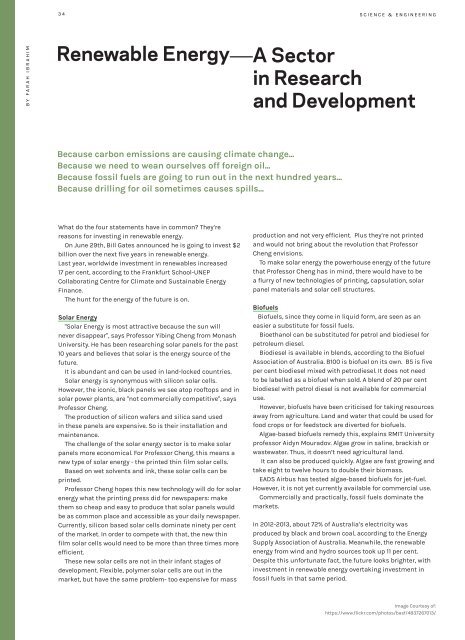Lot's Wife Edition 6 2015
Create successful ePaper yourself
Turn your PDF publications into a flip-book with our unique Google optimized e-Paper software.
34<br />
SCIENCE & ENGINEERING<br />
By Farah Ibrahim<br />
Renewable Energy<br />
A Sector<br />
in Research<br />
and Development<br />
Because carbon emissions are causing climate change...<br />
Because we need to wean ourselves off foreign oil...<br />
Because fossil fuels are going to run out in the next hundred years...<br />
Because drilling for oil sometimes causes spills...<br />
What do the four statements have in common? They’re<br />
reasons for investing in renewable energy.<br />
On June 29th, Bill Gates announced he is going to invest $2<br />
billion over the next five years in renewable energy.<br />
Last year, worldwide investment in renewables increased<br />
17 per cent, according to the Frankfurt School-UNEP<br />
Collaborating Centre for Climate and Sustainable Energy<br />
Finance.<br />
The hunt for the energy of the future is on.<br />
Solar Energy<br />
"Solar Energy is most attractive because the sun will<br />
never disappear", says Professor Yibing Cheng from Monash<br />
University. He has been researching solar panels for the past<br />
10 years and believes that solar is the energy source of the<br />
future.<br />
It is abundant and can be used in land-locked countries.<br />
Solar energy is synonymous with silicon solar cells.<br />
However, the iconic, black panels we see atop rooftops and in<br />
solar power plants, are "not commercially competitive", says<br />
Professor Cheng.<br />
The production of silicon wafers and silica sand used<br />
in these panels are expensive. So is their installation and<br />
maintenance.<br />
The challenge of the solar energy sector is to make solar<br />
panels more economical. For Professor Cheng, this means a<br />
new type of solar energy - the printed thin film solar cells.<br />
Based on wet solvents and ink, these solar cells can be<br />
printed.<br />
Professor Cheng hopes this new technology will do for solar<br />
energy what the printing press did for newspapers: make<br />
them so cheap and easy to produce that solar panels would<br />
be as common place and accessible as your daily newspaper.<br />
Currently, silicon based solar cells dominate ninety per cent<br />
of the market. In order to compete with that, the new thin<br />
film solar cells would need to be more than three times more<br />
efficient.<br />
These new solar cells are not in their infant stages of<br />
development. Flexible, polymer solar cells are out in the<br />
market, but have the same problem- too expensive for mass<br />
production and not very efficient. Plus they’re not printed<br />
and would not bring about the revolution that Professor<br />
Cheng envisions.<br />
To make solar energy the powerhouse energy of the future<br />
that Professor Cheng has in mind, there would have to be<br />
a flurry of new technologies of printing, capsulation, solar<br />
panel materials and solar cell structures.<br />
Biofuels<br />
Biofuels, since they come in liquid form, are seen as an<br />
easier a substitute for fossil fuels.<br />
Bioethanol can be substituted for petrol and biodiesel for<br />
petroleum diesel.<br />
Biodiesel is available in blends, according to the Biofuel<br />
Association of Australia. B100 is biofuel on its own. B5 is five<br />
per cent biodiesel mixed with petrodiesel. It does not need<br />
to be labelled as a biofuel when sold. A blend of 20 per cent<br />
biodiesel with petrol diesel is not available for commercial<br />
use.<br />
However, biofuels have been criticised for taking resources<br />
away from agriculture. Land and water that could be used for<br />
food crops or for feedstock are diverted for biofuels.<br />
Algae-based biofuels remedy this, explains RMIT University<br />
professor Aidyn Mouradov. Algae grow in saline, brackish or<br />
wastewater. Thus, it doesn’t need agricultural land.<br />
It can also be produced quickly. Algae are fast growing and<br />
take eight to twelve hours to double their biomass.<br />
EADS Airbus has tested algae-based biofuels for jet-fuel.<br />
However, it is not yet currently available for commercial use.<br />
Commercially and practically, fossil fuels dominate the<br />
markets.<br />
In 2012-2013, about 72% of Australia’s electricity was<br />
produced by black and brown coal, according to the Energy<br />
Supply Association of Australia. Meanwhile, the renewable<br />
energy from wind and hydro sources took up 11 per cent.<br />
Despite this unfortunate fact, the future looks brighter, with<br />
investment in renewable energy overtaking investment in<br />
fossil fuels in that same period.<br />
Image Courtesy of:<br />
https://www.flickr.com/photos/basf/4837267013/

















